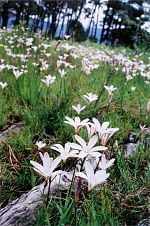Die Oog Conservation Area
Nature reserves in Cape TownProtected areas of the Western Cape

Die Oog Conservation Area is a tiny 1.2-hectare (3.0-acre) nature reserve within the city of Cape Town, South Africa. It is located in the suburb of Bergvliet in the southern portion of Cape Town and includes a lake with an artificial island, a wetland, a garden and a small area of indigenous and endangered Peninsula Granite Fynbos. The recreational area has been planted with indigenous trees such as the unique and striking Silvertree (Leucadendron argenteum), and the wetland is one of the few remaining breeding grounds of the endangered Western Leopard Toad.
Excerpt from the Wikipedia article Die Oog Conservation Area (License: CC BY-SA 3.0, Authors, Images).Die Oog Conservation Area
Midwood Avenue,
Geographical coordinates (GPS) Address Nearby Places Show on map
Geographical coordinates (GPS)
| Latitude | Longitude |
|---|---|
| N -34.048055555556 ° | E 18.4475 ° |
Address
Die Oog
Midwood Avenue
7945 , Cape Town Ward 73
Western Cape, South Africa
Open on Google Maps






